SRT112 Sustainable Construction: Retrofitting with Technologies
VerifiedAdded on 2023/06/13
|18
|3196
|62
Report
AI Summary
This report explores various energy efficiency methods and sustainable technologies applicable for retrofitting residential homes. It discusses self-heating and cooling mechanisms using double-walled insulation, solar water heater systems, LED lighting solutions, and solar energy utilization. It also covers water conservation measures like rainwater harvesting, water treatment, and water recycling, alongside the implementation of smart devices for automated energy regulation. Each technology is assessed for its environmental impact, energy efficiency, and compared with older, less sustainable alternatives, highlighting both advantages and disadvantages. The report concludes by briefly describing a three-bedroom maisonette and its potential for implementing these sustainable retrofitting solutions. Desklib offers a platform to explore more solved assignments and past papers.
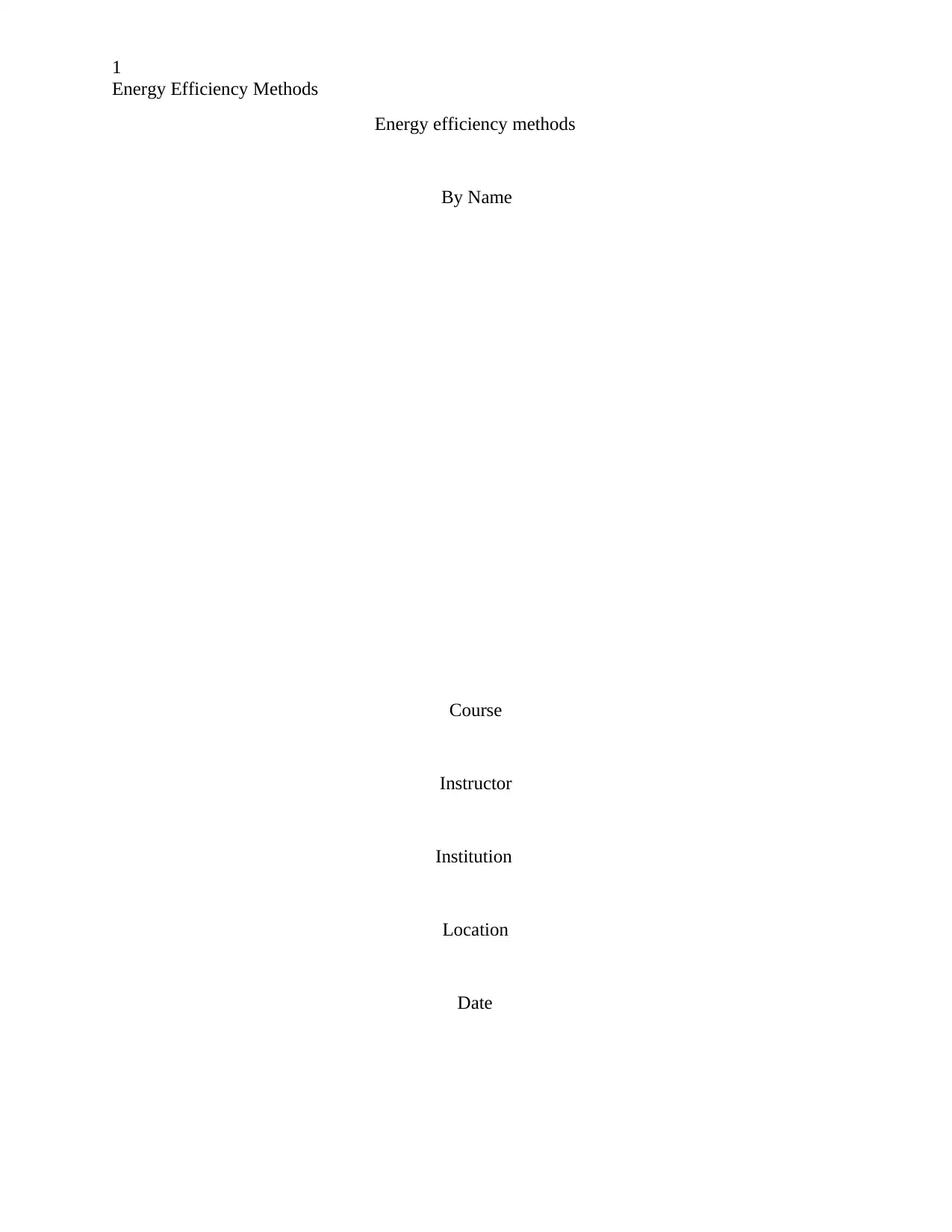
1
Energy Efficiency Methods
Energy efficiency methods
By Name
Course
Instructor
Institution
Location
Date
Energy Efficiency Methods
Energy efficiency methods
By Name
Course
Instructor
Institution
Location
Date
Paraphrase This Document
Need a fresh take? Get an instant paraphrase of this document with our AI Paraphraser

2
Energy Efficiency Methods
Task one
1. Introduction.
Energy is essential in human lives as it gives us light, heat, electricity amongst others.
With ever-advancing population pressure, there is a need for efficient and sustainable
consumption without depleting its sources while conserving the environment as well. Scientists
are researching on game changer technological ideas that will help achieve not only efficiency
and sustainability but also environmental conservation as well. The following are some of the
energy efficiency technological ideas discussed in detail.
1.1 Heating and cooling - self-heating and cooling
mechanism
Heating is the process of increasing the temperature of a room to suit one’s needs while
cooling is the lowering of temperature. Heating can be achieved in several ways such as using
heaters, kilns, blowing hot air in double-walled houses or passing hot water on piped walls. On
the other hand, cooling is achieved by using air conditioners, fans amongst others.
A house can be designed to retain its inner heat during cold season without having to
depend on external heating mechanisms. Such a house is built with a double wall, with space left
in between the walls (Beloglazov et al., 2011). This space is then filled with wool. Wool being a
bad conductor of heat, will prevent excessive heat from penetrating into the house during
summer and hot weather and prevent heat available in the house from leaking outside during
winter and cold weather. This mechanism will help regulate the temperature of a house
throughout the year.
Energy Efficiency Methods
Task one
1. Introduction.
Energy is essential in human lives as it gives us light, heat, electricity amongst others.
With ever-advancing population pressure, there is a need for efficient and sustainable
consumption without depleting its sources while conserving the environment as well. Scientists
are researching on game changer technological ideas that will help achieve not only efficiency
and sustainability but also environmental conservation as well. The following are some of the
energy efficiency technological ideas discussed in detail.
1.1 Heating and cooling - self-heating and cooling
mechanism
Heating is the process of increasing the temperature of a room to suit one’s needs while
cooling is the lowering of temperature. Heating can be achieved in several ways such as using
heaters, kilns, blowing hot air in double-walled houses or passing hot water on piped walls. On
the other hand, cooling is achieved by using air conditioners, fans amongst others.
A house can be designed to retain its inner heat during cold season without having to
depend on external heating mechanisms. Such a house is built with a double wall, with space left
in between the walls (Beloglazov et al., 2011). This space is then filled with wool. Wool being a
bad conductor of heat, will prevent excessive heat from penetrating into the house during
summer and hot weather and prevent heat available in the house from leaking outside during
winter and cold weather. This mechanism will help regulate the temperature of a house
throughout the year.
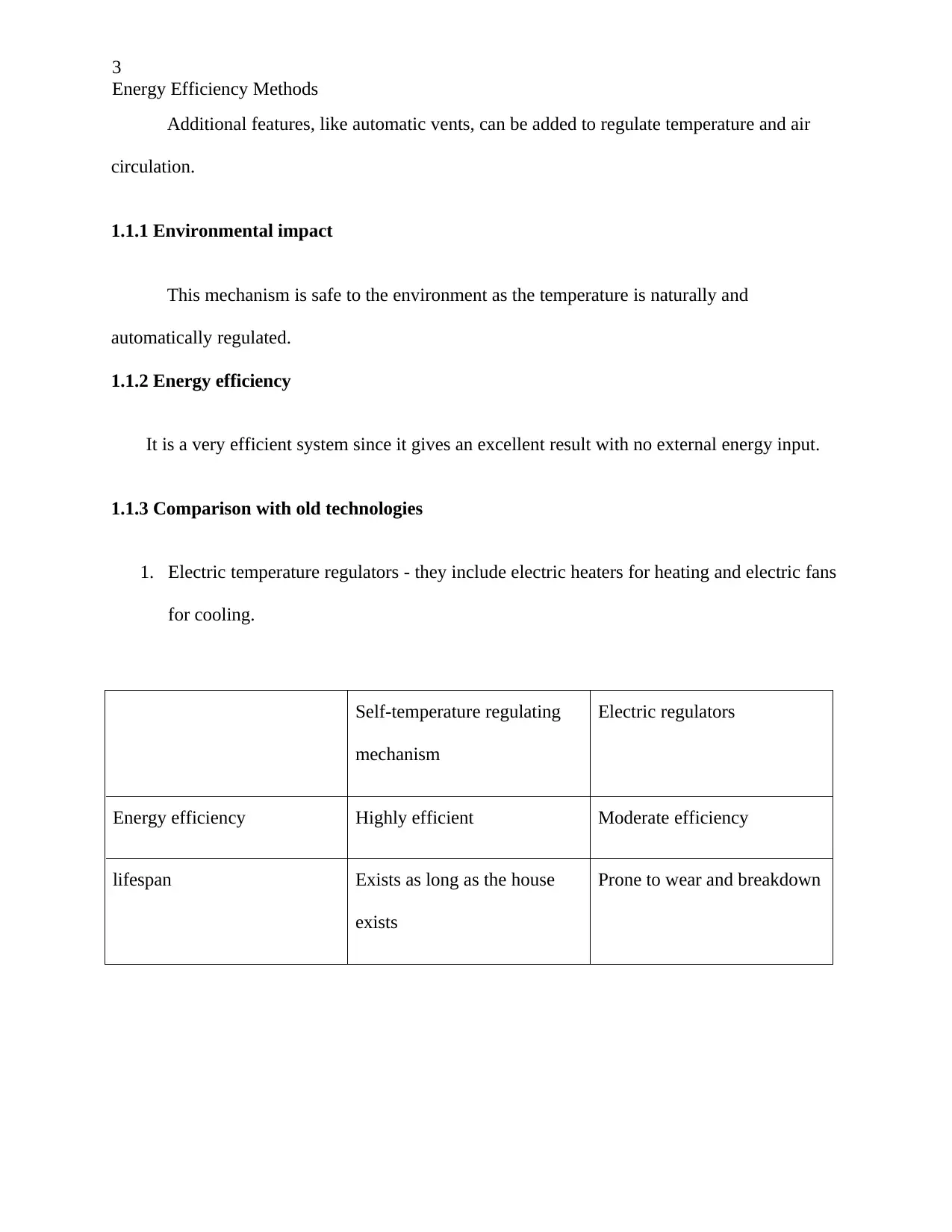
3
Energy Efficiency Methods
Additional features, like automatic vents, can be added to regulate temperature and air
circulation.
1.1.1 Environmental impact
This mechanism is safe to the environment as the temperature is naturally and
automatically regulated.
1.1.2 Energy efficiency
It is a very efficient system since it gives an excellent result with no external energy input.
1.1.3 Comparison with old technologies
1. Electric temperature regulators - they include electric heaters for heating and electric fans
for cooling.
Self-temperature regulating
mechanism
Electric regulators
Energy efficiency Highly efficient Moderate efficiency
lifespan Exists as long as the house
exists
Prone to wear and breakdown
Energy Efficiency Methods
Additional features, like automatic vents, can be added to regulate temperature and air
circulation.
1.1.1 Environmental impact
This mechanism is safe to the environment as the temperature is naturally and
automatically regulated.
1.1.2 Energy efficiency
It is a very efficient system since it gives an excellent result with no external energy input.
1.1.3 Comparison with old technologies
1. Electric temperature regulators - they include electric heaters for heating and electric fans
for cooling.
Self-temperature regulating
mechanism
Electric regulators
Energy efficiency Highly efficient Moderate efficiency
lifespan Exists as long as the house
exists
Prone to wear and breakdown
⊘ This is a preview!⊘
Do you want full access?
Subscribe today to unlock all pages.

Trusted by 1+ million students worldwide

4
Energy Efficiency Methods
Advantages
● It is clean and green
● No fuel is needed, hence cheap
● No maintenance costs needed
● Reduces pressure on the grid thus reducing carbon emission
Disadvantages
● May not meet individual temperature needs.
1.2 Solar water heater systems
Solar water heating refers to the tapping of heat and light from the sun for heating water
using a solar thermal collector (Lee et al., 2012). Solar water heaters make use of the free solar
energy to heat water rather than sucking electricity for the same purpose.
1.2.1 Environmental impact
Solar water heaters are environmentally friendly as there is no carbon emission. In fact, solar
water heaters indirectly reduce the emission of carbon. As the overreliance on electricity for
heating is reduced, pressure on the use of fossil fuels to generate electricity is significantly
reduced (Ng et al., 2012).
Energy Efficiency Methods
Advantages
● It is clean and green
● No fuel is needed, hence cheap
● No maintenance costs needed
● Reduces pressure on the grid thus reducing carbon emission
Disadvantages
● May not meet individual temperature needs.
1.2 Solar water heater systems
Solar water heating refers to the tapping of heat and light from the sun for heating water
using a solar thermal collector (Lee et al., 2012). Solar water heaters make use of the free solar
energy to heat water rather than sucking electricity for the same purpose.
1.2.1 Environmental impact
Solar water heaters are environmentally friendly as there is no carbon emission. In fact, solar
water heaters indirectly reduce the emission of carbon. As the overreliance on electricity for
heating is reduced, pressure on the use of fossil fuels to generate electricity is significantly
reduced (Ng et al., 2012).
Paraphrase This Document
Need a fresh take? Get an instant paraphrase of this document with our AI Paraphraser
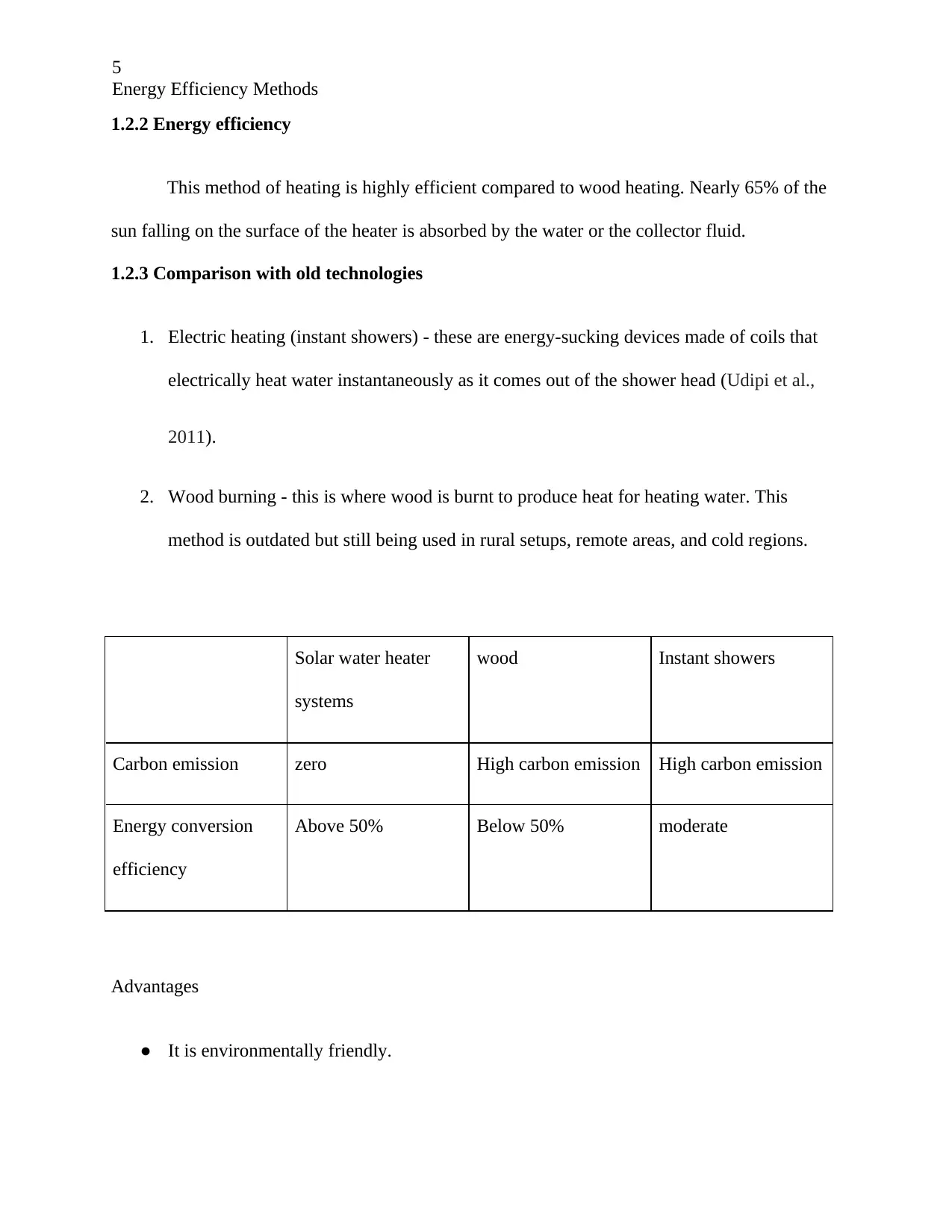
5
Energy Efficiency Methods
1.2.2 Energy efficiency
This method of heating is highly efficient compared to wood heating. Nearly 65% of the
sun falling on the surface of the heater is absorbed by the water or the collector fluid.
1.2.3 Comparison with old technologies
1. Electric heating (instant showers) - these are energy-sucking devices made of coils that
electrically heat water instantaneously as it comes out of the shower head (Udipi et al.,
2011).
2. Wood burning - this is where wood is burnt to produce heat for heating water. This
method is outdated but still being used in rural setups, remote areas, and cold regions.
Solar water heater
systems
wood Instant showers
Carbon emission zero High carbon emission High carbon emission
Energy conversion
efficiency
Above 50% Below 50% moderate
Advantages
● It is environmentally friendly.
Energy Efficiency Methods
1.2.2 Energy efficiency
This method of heating is highly efficient compared to wood heating. Nearly 65% of the
sun falling on the surface of the heater is absorbed by the water or the collector fluid.
1.2.3 Comparison with old technologies
1. Electric heating (instant showers) - these are energy-sucking devices made of coils that
electrically heat water instantaneously as it comes out of the shower head (Udipi et al.,
2011).
2. Wood burning - this is where wood is burnt to produce heat for heating water. This
method is outdated but still being used in rural setups, remote areas, and cold regions.
Solar water heater
systems
wood Instant showers
Carbon emission zero High carbon emission High carbon emission
Energy conversion
efficiency
Above 50% Below 50% moderate
Advantages
● It is environmentally friendly.
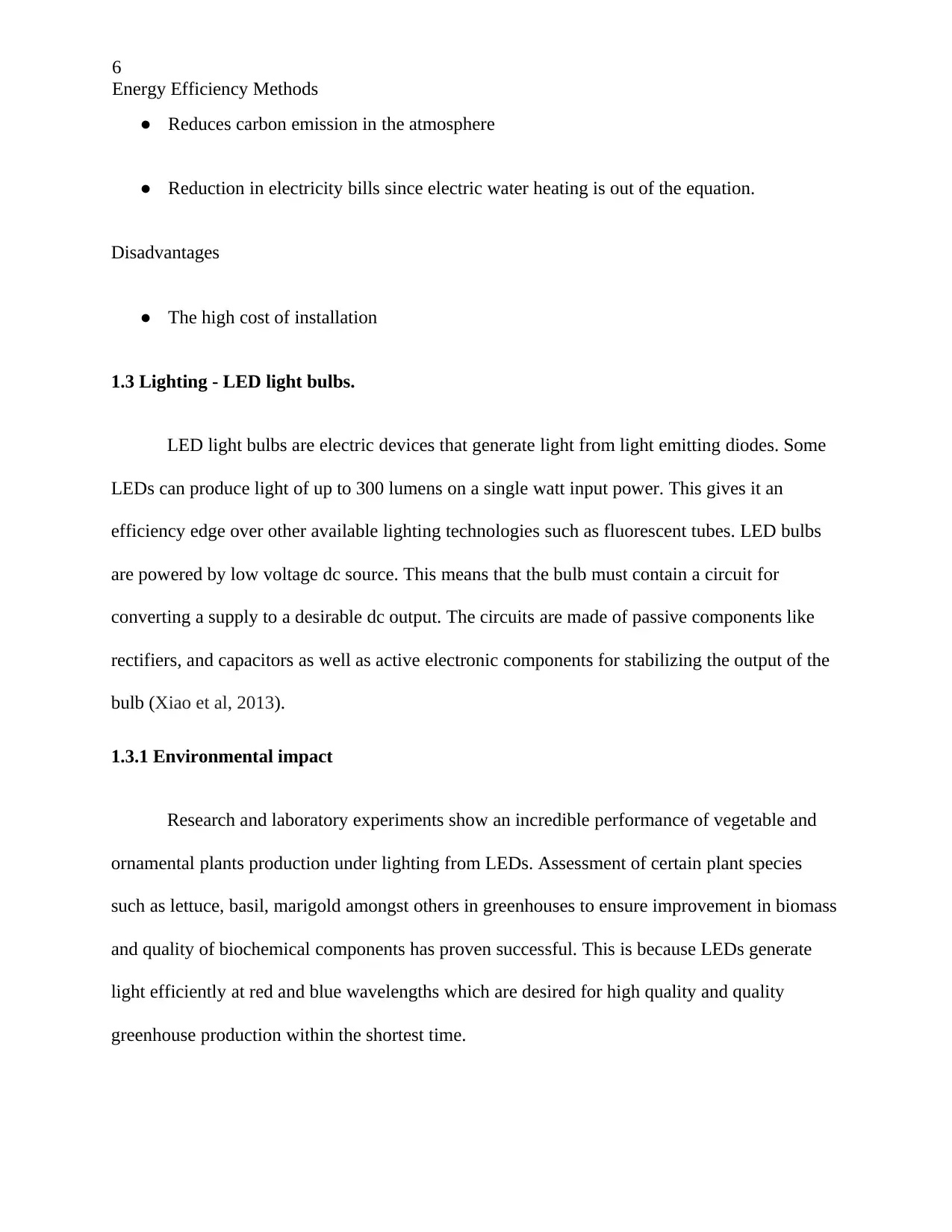
6
Energy Efficiency Methods
● Reduces carbon emission in the atmosphere
● Reduction in electricity bills since electric water heating is out of the equation.
Disadvantages
● The high cost of installation
1.3 Lighting - LED light bulbs.
LED light bulbs are electric devices that generate light from light emitting diodes. Some
LEDs can produce light of up to 300 lumens on a single watt input power. This gives it an
efficiency edge over other available lighting technologies such as fluorescent tubes. LED bulbs
are powered by low voltage dc source. This means that the bulb must contain a circuit for
converting a supply to a desirable dc output. The circuits are made of passive components like
rectifiers, and capacitors as well as active electronic components for stabilizing the output of the
bulb (Xiao et al, 2013).
1.3.1 Environmental impact
Research and laboratory experiments show an incredible performance of vegetable and
ornamental plants production under lighting from LEDs. Assessment of certain plant species
such as lettuce, basil, marigold amongst others in greenhouses to ensure improvement in biomass
and quality of biochemical components has proven successful. This is because LEDs generate
light efficiently at red and blue wavelengths which are desired for high quality and quality
greenhouse production within the shortest time.
Energy Efficiency Methods
● Reduces carbon emission in the atmosphere
● Reduction in electricity bills since electric water heating is out of the equation.
Disadvantages
● The high cost of installation
1.3 Lighting - LED light bulbs.
LED light bulbs are electric devices that generate light from light emitting diodes. Some
LEDs can produce light of up to 300 lumens on a single watt input power. This gives it an
efficiency edge over other available lighting technologies such as fluorescent tubes. LED bulbs
are powered by low voltage dc source. This means that the bulb must contain a circuit for
converting a supply to a desirable dc output. The circuits are made of passive components like
rectifiers, and capacitors as well as active electronic components for stabilizing the output of the
bulb (Xiao et al, 2013).
1.3.1 Environmental impact
Research and laboratory experiments show an incredible performance of vegetable and
ornamental plants production under lighting from LEDs. Assessment of certain plant species
such as lettuce, basil, marigold amongst others in greenhouses to ensure improvement in biomass
and quality of biochemical components has proven successful. This is because LEDs generate
light efficiently at red and blue wavelengths which are desired for high quality and quality
greenhouse production within the shortest time.
⊘ This is a preview!⊘
Do you want full access?
Subscribe today to unlock all pages.

Trusted by 1+ million students worldwide
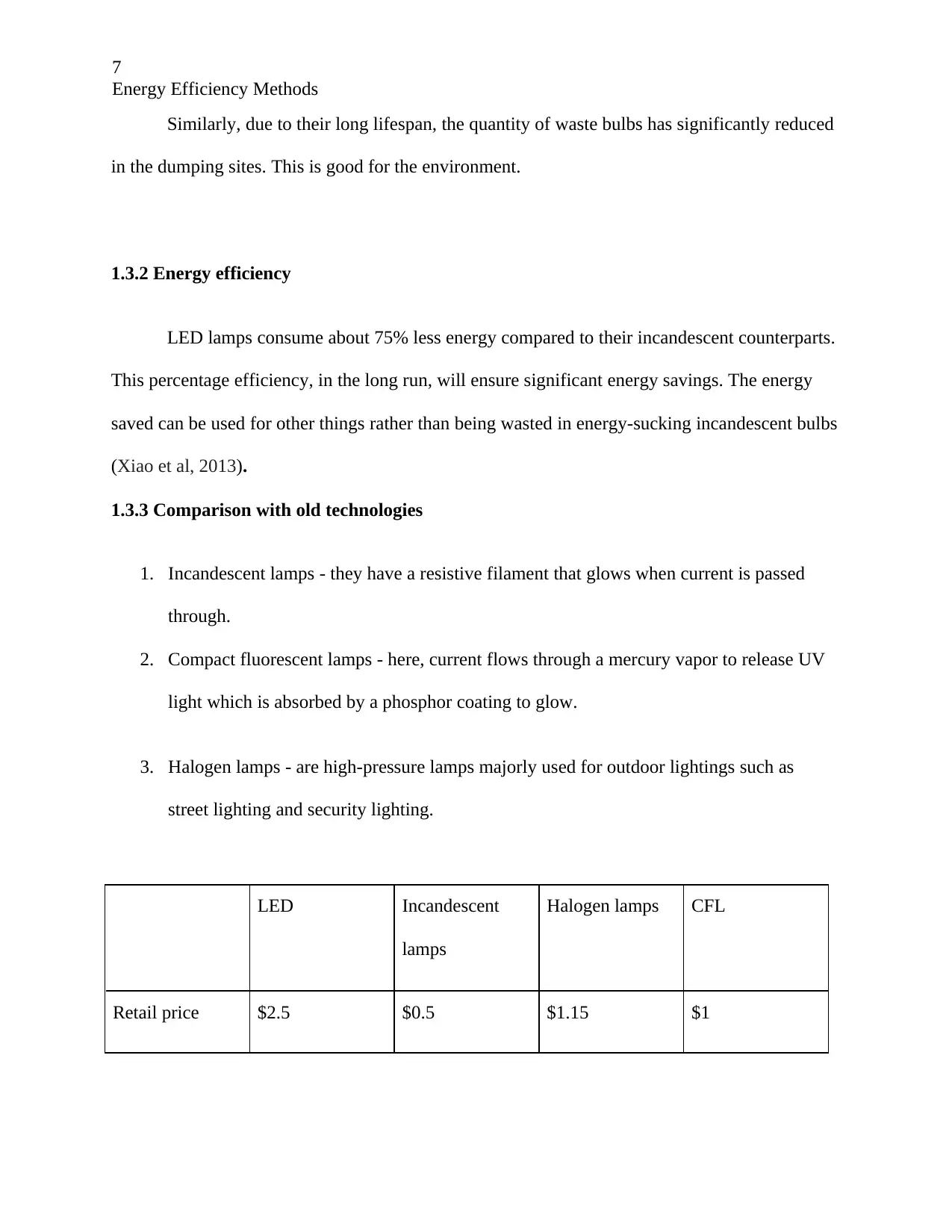
7
Energy Efficiency Methods
Similarly, due to their long lifespan, the quantity of waste bulbs has significantly reduced
in the dumping sites. This is good for the environment.
1.3.2 Energy efficiency
LED lamps consume about 75% less energy compared to their incandescent counterparts.
This percentage efficiency, in the long run, will ensure significant energy savings. The energy
saved can be used for other things rather than being wasted in energy-sucking incandescent bulbs
(Xiao et al, 2013).
1.3.3 Comparison with old technologies
1. Incandescent lamps - they have a resistive filament that glows when current is passed
through.
2. Compact fluorescent lamps - here, current flows through a mercury vapor to release UV
light which is absorbed by a phosphor coating to glow.
3. Halogen lamps - are high-pressure lamps majorly used for outdoor lightings such as
street lighting and security lighting.
LED Incandescent
lamps
Halogen lamps CFL
Retail price $2.5 $0.5 $1.15 $1
Energy Efficiency Methods
Similarly, due to their long lifespan, the quantity of waste bulbs has significantly reduced
in the dumping sites. This is good for the environment.
1.3.2 Energy efficiency
LED lamps consume about 75% less energy compared to their incandescent counterparts.
This percentage efficiency, in the long run, will ensure significant energy savings. The energy
saved can be used for other things rather than being wasted in energy-sucking incandescent bulbs
(Xiao et al, 2013).
1.3.3 Comparison with old technologies
1. Incandescent lamps - they have a resistive filament that glows when current is passed
through.
2. Compact fluorescent lamps - here, current flows through a mercury vapor to release UV
light which is absorbed by a phosphor coating to glow.
3. Halogen lamps - are high-pressure lamps majorly used for outdoor lightings such as
street lighting and security lighting.
LED Incandescent
lamps
Halogen lamps CFL
Retail price $2.5 $0.5 $1.15 $1
Paraphrase This Document
Need a fresh take? Get an instant paraphrase of this document with our AI Paraphraser

8
Energy Efficiency Methods
Lumens per watt 98.1 14.5 17.1 56.1
Durability
(hours)
Approx. 17000 Approx. 1000 Approx. 1000 Approx. 10000
Power rating
(watts)
8.3 60 43 14
Advantages
● Reduction of cost of energy since they use 75% less energy compared to incandescent.
● Produces negligible heat
● Lasts long
● Reduction in maintenance costs due to a longer lifespan
● Perfect quality of color
● A higher power factor of about 0.7
Disadvantages
● Prone to flickering due to a fluctuation of dc power input.
● There efficiency and durability are reduced by elevated temperatures.
Energy Efficiency Methods
Lumens per watt 98.1 14.5 17.1 56.1
Durability
(hours)
Approx. 17000 Approx. 1000 Approx. 1000 Approx. 10000
Power rating
(watts)
8.3 60 43 14
Advantages
● Reduction of cost of energy since they use 75% less energy compared to incandescent.
● Produces negligible heat
● Lasts long
● Reduction in maintenance costs due to a longer lifespan
● Perfect quality of color
● A higher power factor of about 0.7
Disadvantages
● Prone to flickering due to a fluctuation of dc power input.
● There efficiency and durability are reduced by elevated temperatures.
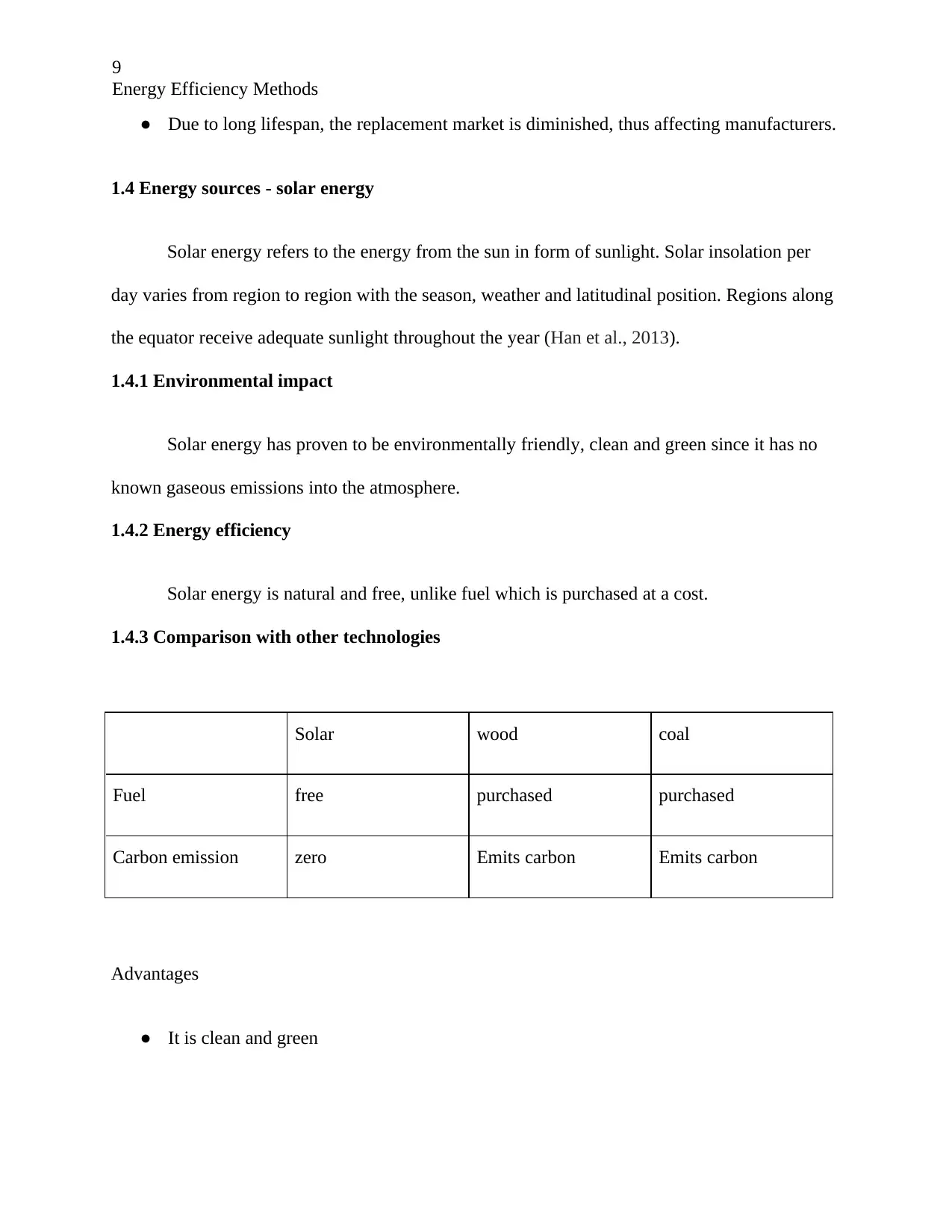
9
Energy Efficiency Methods
● Due to long lifespan, the replacement market is diminished, thus affecting manufacturers.
1.4 Energy sources - solar energy
Solar energy refers to the energy from the sun in form of sunlight. Solar insolation per
day varies from region to region with the season, weather and latitudinal position. Regions along
the equator receive adequate sunlight throughout the year (Han et al., 2013).
1.4.1 Environmental impact
Solar energy has proven to be environmentally friendly, clean and green since it has no
known gaseous emissions into the atmosphere.
1.4.2 Energy efficiency
Solar energy is natural and free, unlike fuel which is purchased at a cost.
1.4.3 Comparison with other technologies
Solar wood coal
Fuel free purchased purchased
Carbon emission zero Emits carbon Emits carbon
Advantages
● It is clean and green
Energy Efficiency Methods
● Due to long lifespan, the replacement market is diminished, thus affecting manufacturers.
1.4 Energy sources - solar energy
Solar energy refers to the energy from the sun in form of sunlight. Solar insolation per
day varies from region to region with the season, weather and latitudinal position. Regions along
the equator receive adequate sunlight throughout the year (Han et al., 2013).
1.4.1 Environmental impact
Solar energy has proven to be environmentally friendly, clean and green since it has no
known gaseous emissions into the atmosphere.
1.4.2 Energy efficiency
Solar energy is natural and free, unlike fuel which is purchased at a cost.
1.4.3 Comparison with other technologies
Solar wood coal
Fuel free purchased purchased
Carbon emission zero Emits carbon Emits carbon
Advantages
● It is clean and green
⊘ This is a preview!⊘
Do you want full access?
Subscribe today to unlock all pages.

Trusted by 1+ million students worldwide

10
Energy Efficiency Methods
● Cheaper cost of maintenance
● Help reduce pressure on the grid, thus reducing carbon emission
● Higher efficiency than gas thermal stations
● Energy can be stored in batteries
● Surplus can be sold to the grid
Disadvantages
● Lower efficiency compared to many conventional methods.
1.5 Solar panels and electricity storage
Solar panels convert sunlight into electricity. Technologies are frequently being
developed and improved by scientists to tap maximum solar energy. Conversion of solar energy
to electricity require solar photovoltaic modules. PV modules are made up of numerous diodes
that convert sunlight to electricity (Chua et al., 2013).
Batteries are connected to the solar panels for storing surplus electricity to be used at
night. Batteries provide energy sustainability as well as electricity independence to the
household.
1.5.1 Environmental impact
Generation of electricity using solar panels is clean with zero carbon emissions. Solar
panels averagely have a lifespan of 20years. Solar panel and battery wastes can be taken for
Energy Efficiency Methods
● Cheaper cost of maintenance
● Help reduce pressure on the grid, thus reducing carbon emission
● Higher efficiency than gas thermal stations
● Energy can be stored in batteries
● Surplus can be sold to the grid
Disadvantages
● Lower efficiency compared to many conventional methods.
1.5 Solar panels and electricity storage
Solar panels convert sunlight into electricity. Technologies are frequently being
developed and improved by scientists to tap maximum solar energy. Conversion of solar energy
to electricity require solar photovoltaic modules. PV modules are made up of numerous diodes
that convert sunlight to electricity (Chua et al., 2013).
Batteries are connected to the solar panels for storing surplus electricity to be used at
night. Batteries provide energy sustainability as well as electricity independence to the
household.
1.5.1 Environmental impact
Generation of electricity using solar panels is clean with zero carbon emissions. Solar
panels averagely have a lifespan of 20years. Solar panel and battery wastes can be taken for
Paraphrase This Document
Need a fresh take? Get an instant paraphrase of this document with our AI Paraphraser
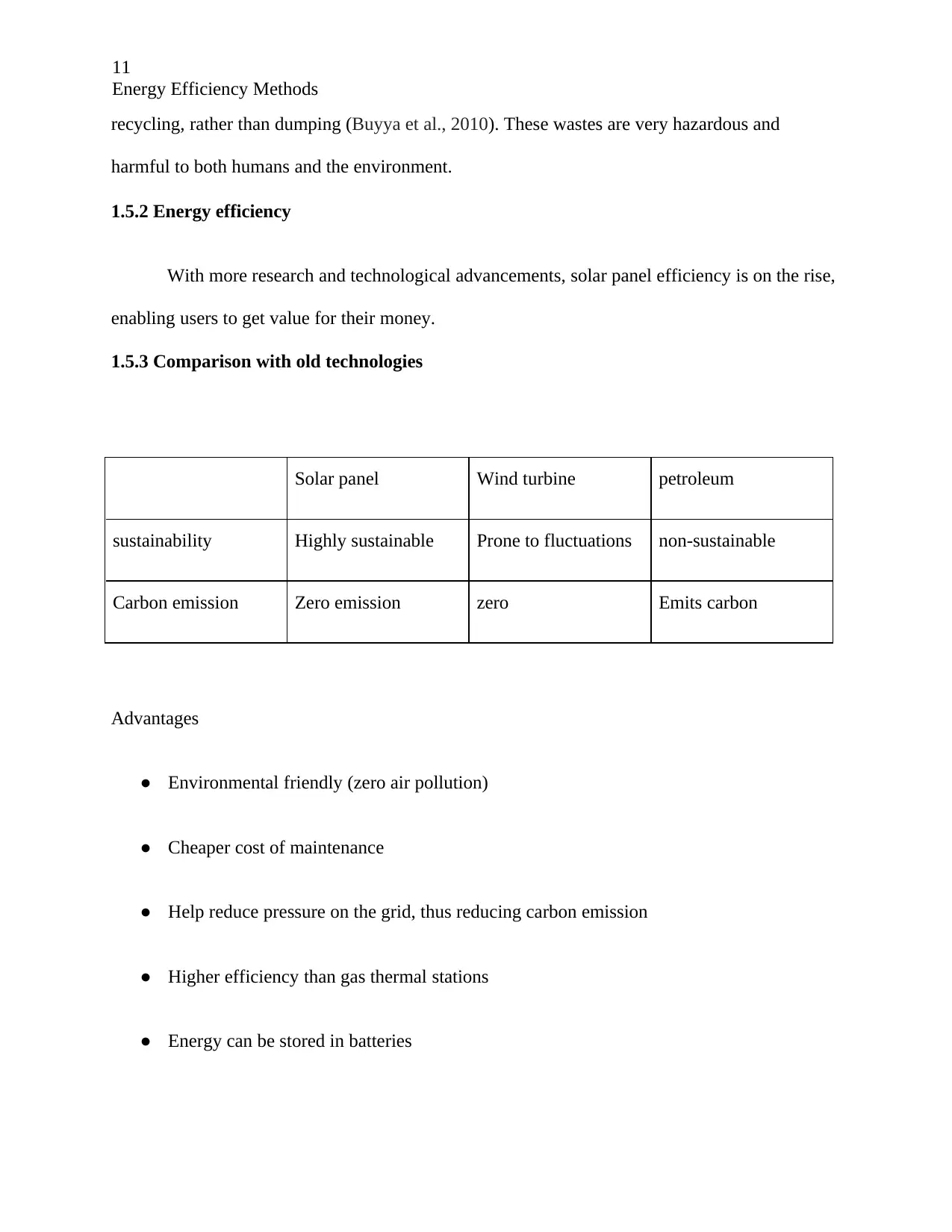
11
Energy Efficiency Methods
recycling, rather than dumping (Buyya et al., 2010). These wastes are very hazardous and
harmful to both humans and the environment.
1.5.2 Energy efficiency
With more research and technological advancements, solar panel efficiency is on the rise,
enabling users to get value for their money.
1.5.3 Comparison with old technologies
Solar panel Wind turbine petroleum
sustainability Highly sustainable Prone to fluctuations non-sustainable
Carbon emission Zero emission zero Emits carbon
Advantages
● Environmental friendly (zero air pollution)
● Cheaper cost of maintenance
● Help reduce pressure on the grid, thus reducing carbon emission
● Higher efficiency than gas thermal stations
● Energy can be stored in batteries
Energy Efficiency Methods
recycling, rather than dumping (Buyya et al., 2010). These wastes are very hazardous and
harmful to both humans and the environment.
1.5.2 Energy efficiency
With more research and technological advancements, solar panel efficiency is on the rise,
enabling users to get value for their money.
1.5.3 Comparison with old technologies
Solar panel Wind turbine petroleum
sustainability Highly sustainable Prone to fluctuations non-sustainable
Carbon emission Zero emission zero Emits carbon
Advantages
● Environmental friendly (zero air pollution)
● Cheaper cost of maintenance
● Help reduce pressure on the grid, thus reducing carbon emission
● Higher efficiency than gas thermal stations
● Energy can be stored in batteries
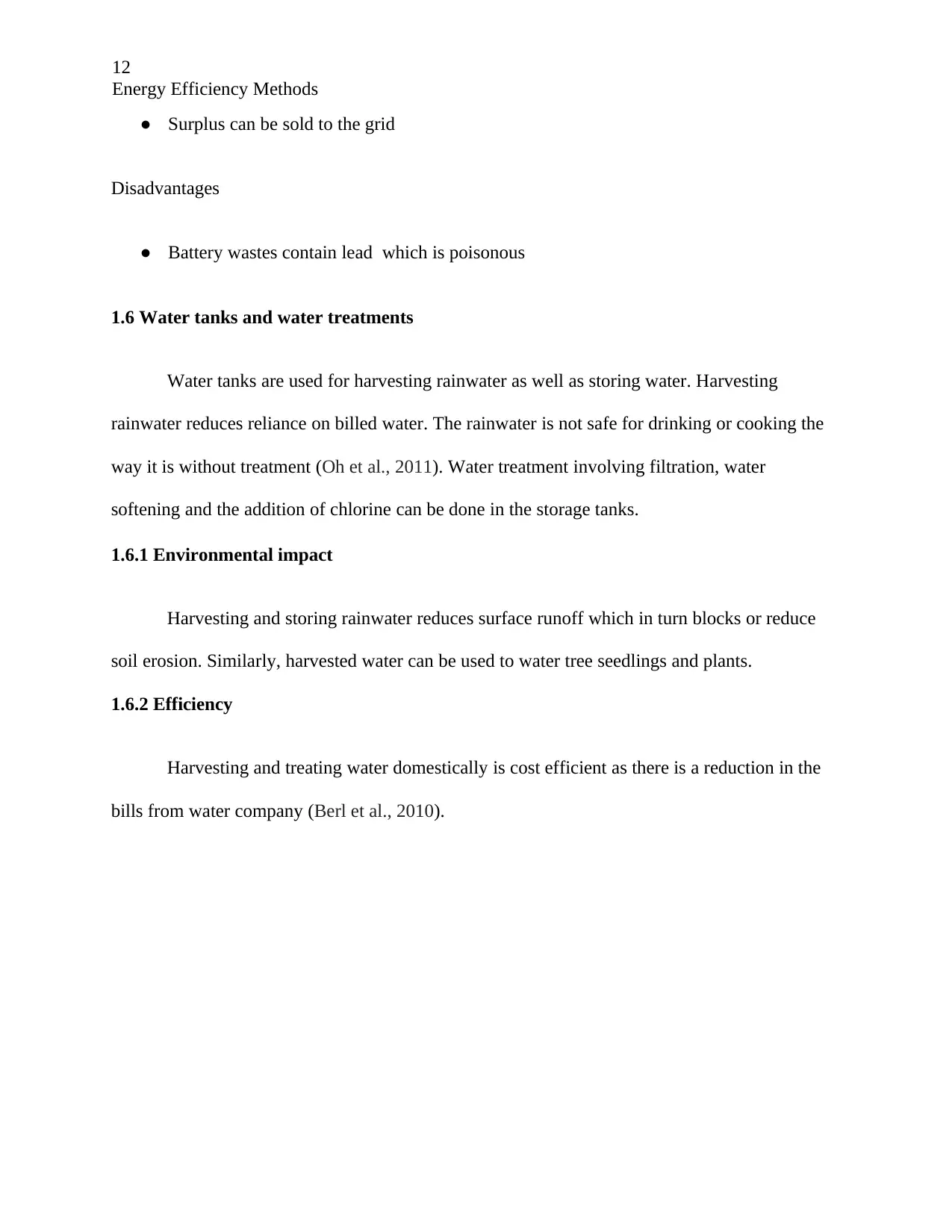
12
Energy Efficiency Methods
● Surplus can be sold to the grid
Disadvantages
● Battery wastes contain lead which is poisonous
1.6 Water tanks and water treatments
Water tanks are used for harvesting rainwater as well as storing water. Harvesting
rainwater reduces reliance on billed water. The rainwater is not safe for drinking or cooking the
way it is without treatment (Oh et al., 2011). Water treatment involving filtration, water
softening and the addition of chlorine can be done in the storage tanks.
1.6.1 Environmental impact
Harvesting and storing rainwater reduces surface runoff which in turn blocks or reduce
soil erosion. Similarly, harvested water can be used to water tree seedlings and plants.
1.6.2 Efficiency
Harvesting and treating water domestically is cost efficient as there is a reduction in the
bills from water company (Berl et al., 2010).
Energy Efficiency Methods
● Surplus can be sold to the grid
Disadvantages
● Battery wastes contain lead which is poisonous
1.6 Water tanks and water treatments
Water tanks are used for harvesting rainwater as well as storing water. Harvesting
rainwater reduces reliance on billed water. The rainwater is not safe for drinking or cooking the
way it is without treatment (Oh et al., 2011). Water treatment involving filtration, water
softening and the addition of chlorine can be done in the storage tanks.
1.6.1 Environmental impact
Harvesting and storing rainwater reduces surface runoff which in turn blocks or reduce
soil erosion. Similarly, harvested water can be used to water tree seedlings and plants.
1.6.2 Efficiency
Harvesting and treating water domestically is cost efficient as there is a reduction in the
bills from water company (Berl et al., 2010).
⊘ This is a preview!⊘
Do you want full access?
Subscribe today to unlock all pages.

Trusted by 1+ million students worldwide
1 out of 18
Related Documents
Your All-in-One AI-Powered Toolkit for Academic Success.
+13062052269
info@desklib.com
Available 24*7 on WhatsApp / Email
![[object Object]](/_next/static/media/star-bottom.7253800d.svg)
Unlock your academic potential
Copyright © 2020–2025 A2Z Services. All Rights Reserved. Developed and managed by ZUCOL.





